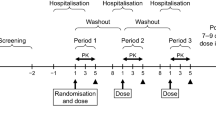Summary
Single doses of epanolol (ICI 141,292) were administered to 12 healthy young male volunteers in a randomised crossover study. Each volunteer received a 200mg tablet, 200mg in solution or 5mg intravenously under fasting conditions, or a 200mg tablet with food. Venous blood samples were collected up to 72 hours after oral administration and 12 hours after intravenous administration. The concentrations of epanolol in plasma were determined by use of a radio-immunoassay technique, whereas those in urine samples were measured by a high pressure liquid Chromatographic (HPLC) method. Analysis of variance was used to assess the significance of the differences between the groups.
Epanolol plasma concentrations declined biexponentially with time after an intravenous dose, with a half-life of 7 minutes for the first phase and about 3 hours for the second. Plasma clearance was high (2.1 L/min). Peak plasma concentrations of about 30 to 40 ng/ml were observed at mean times of about 1 to 1.5 hours after oral administration. After the peak, plasma concentrations declined biexponentially, with a terminal phase half-life of about 20 hours.
The bioavailability of epanolol for the tablet and solution administered to fasted volunteers was similar (7–8%), but it was about 25% lower when administered as a tablet with food.
Urinary recovery of epanolol was about 25% of the administered intravenous dose, but recoveries were much lower (about 1%) following oral administration.
These data have been compared with those obtained after single oral doses of epanolol 200mg to elderly patients with angina and subjects with renal or hepatic impairment.
Similar content being viewed by others
References
Collett JT, Hendrickson JA, Chew CYC, Shah PM, Laddu AR, et al. Comparative β-blocking potencies of acebutolol and propranolol relative to plasma drug levels. International Journal of Clinical Pharmacology, Therapy and Toxicology 19: 473–478, 1981
Gibaldi M, Perrier D. In Pharmacokinetics, 2nd ed., Marcel Dekker Inc., New York, 1982
Oberle RL, Amidon GL. The influence of variable gastric emptying and intestinal transit rates on the plasma level curve of cimetidine; an explanation for the double peak phenomenon. Journal of Pharmacokinetics and Biopharmaceutics 15: 529–544, 1987
Plusquellec Y, Campistron G, Staveris S, Barre J, Jung L, et al. A double peak phenomenon in the pharmacokinetics of veralipride after oral administration: a double-site model for drug absorption. Journal of Pharmacokinetics and Biopharmaceutics 15: 225–239, 1987
Von Bahr C, Collste P, Frisk-Holmberg M, Haglund K, Jorfelt L, et al. Plasma levels and effects of metoprolol on blood pressure, adrenergic β-receptor blockade and plasma renin activity in essential hypertension. Clinical Pharmacology and Therapeutics 20: 130–137, 1976
Author information
Authors and Affiliations
Rights and permissions
About this article
Cite this article
Cockshott, I.D. Pharmacokinetics of Epanolol (ICI 141,292) in Healthy Young Volunteers and Comparative Data in Elderly Patients with Angina and Subjects with Renal or Hepatic Impairment. Drugs 38 (Suppl 2), 10–17 (1989). https://doi.org/10.2165/00003495-198900382-00005
Published:
Issue Date:
DOI: https://doi.org/10.2165/00003495-198900382-00005




